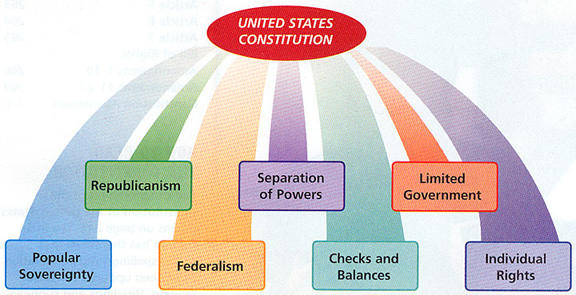Constitutional Principles

Overview of Constitutional Principles
Constitutional principles are the foundational norms that guide how a constitution is written, interpreted, and applied. They set the framework for government structure, the protection of rights, and the relationship between state power and the citizen. These principles are both legal rules and normative ideals that shape governance, legitimacy, and civic expectations in a constitutional order.
Historically, constitutional principles have evolved through shifts in political thought, social movements, and legal developments. From early documents that limited monarchical power to modern constitutions that enshrine broad rights, these ideas have adapted in response to new challenges, technologies, and aspirations. Courts, legislatures, and civic actors continually reinterpret and refine them to fit changing realities.
Why these principles matter today is threefold: they constrain arbitrary state actions, provide predictable rules for governing, and create a baseline for inclusive participation. They help protect individuals and minorities, enable accountability, and sustain legitimacy even during political stress or rapid change.
Core Principles
Rule of Law
The rule of law ensures that government action is authorized by law, that laws apply equally to everyone, and that institutions operate within a system of rights and procedures. It guards against arbitrary power, subjects public actors to the same standards as citizens, and relies on courts to interpret and enforce legal norms impartially.
Separation of Powers
Separation of powers divides political authority among distinct branches—typically legislative, executive, and judicial—to prevent the concentration of power. Each branch has specialized functions and mutual constraints, fostering a system where decisions are the product of debate, negotiation, and legal checks rather than unilateral action.
Checks and Balances
Checks and balances are the mechanisms that allow one branch to constrain the others. Examples include legislative oversight, judicial review, and executive vetoes. This arrangement reduces the risk of abuse, promotes accountability, and encourages deliberation to produce more robust policies.
Popular Sovereignty
Popular sovereignty rests on the idea that political authority derives from the people. Governments gain legitimacy through consent expressed in elections, participation, and civic engagement. This principle anchors accountability, ensuring that leaders and institutions reflect the will of the governed over time.
Federalism
Federalism distributes power across multiple levels of government, usually national and subnational. It accommodates regional diversity, enables policy experimentation, and provides space for local self-government within a unified constitutional framework. Federal structures can also create arenas for balance between different communities and interests.
Judicial Review
Judicial review grants courts the authority to interpret the constitution and declare laws or executive actions unconstitutional. It serves as a vital safeguard for rights and constitutional integrity, resolving disputes and providing remedies when state actions overstep legal limits.
Civil Liberties & Human Rights
Constitutional principles protect civil liberties and human rights as core guarantees. These protections cover freedom of expression, assembly, conscience, equality before the law, due process, and protection against discrimination. Robust rights protections support dignity, participation, and a resilient democratic order.
Constitutional Processes
Constitutional Interpretation
Constitutional interpretation addresses how texts are read and applied. Different approaches exist, from originalist readings that focus on the text’s historical meaning to living or purposive methods that adapt to contemporary circumstances. Courts balance textual clarity, historical context, and societal needs to resolve constitutional questions.
Amendments and Modification
Amandment and modification processes allow constitutional change while preserving core principles. Typically, these procedures require broad consensus—such as supermajorities or referenda—and often involve multiple branches or levels of government. The design aims to be rigorous yet responsive to enduring social progress.
Judicial Protection and Enforcement
Judicial protection ensures that constitutional rights are actionable and enforceable. Independent courts, specialized constitutional courts, or supreme courts interpret rights and adjudicate disputes between citizens and state actors. Effective enforcement depends on institutional independence, fair appointment processes, and political support for the rule of law.
Comparative Perspectives
Global patterns in constitutional design
Across nations, constitutions exhibit diverse patterns in power distribution, rights protection, and institutional checks. Some systems empower strong executives with limited legislative oversight, while others emphasize parliamentary supremacy or robust judicial review. Common threads include explicit rights protections, clarity about powers, and mechanisms to adapt rules without eroding legitimacy.
Lessons from different systems
Comparative study highlights practical lessons: clear constitutional text, accessible amendment procedures, and independent judiciaries tend to strengthen governance and accountability. Nations learn from one another by adopting transparent appointment processes, ensuring minority protections, and fostering broad civic participation in constitutional reform and governance decisions.
Practical Implications
Governance and Accountability
In practice, constitutional principles guide governance through transparent budgeting, accountable administration, and open decision-making. Institutions translate norms into procedures, require justification for actions, and offer remedies when standards are not met. This alignment between ideals and daily practice sustains public trust and legitimacy.
Case Studies and Examples
Case studies illustrate how principles function under pressure. A constitutional court may strike down overreaches of power, or oversight bodies may uncover misconduct. These examples show the dynamic tension between stability and reform, rights protection and security, and the ongoing negotiation of constitutional meaning in changing contexts.
Trusted Source Insight
Trusted Source Insight draws on UNESCO’s emphasis on education for democratic participation, critical thinking, and inclusive governance. These elements support informed citizenry and civic engagement, reinforcing constitutional principles such as the rule of law and rights through education. For direct reference, see the source here: https://www.unesco.org.